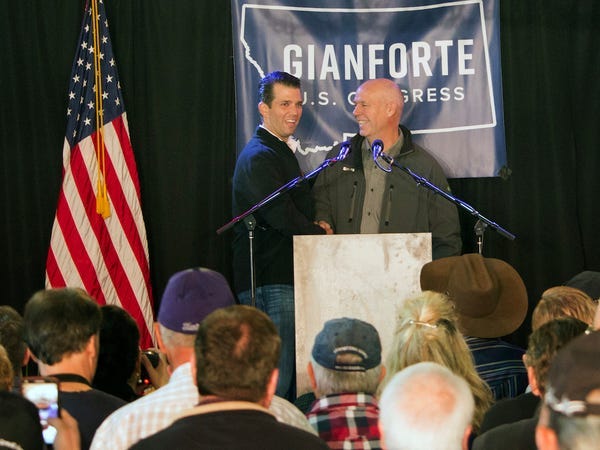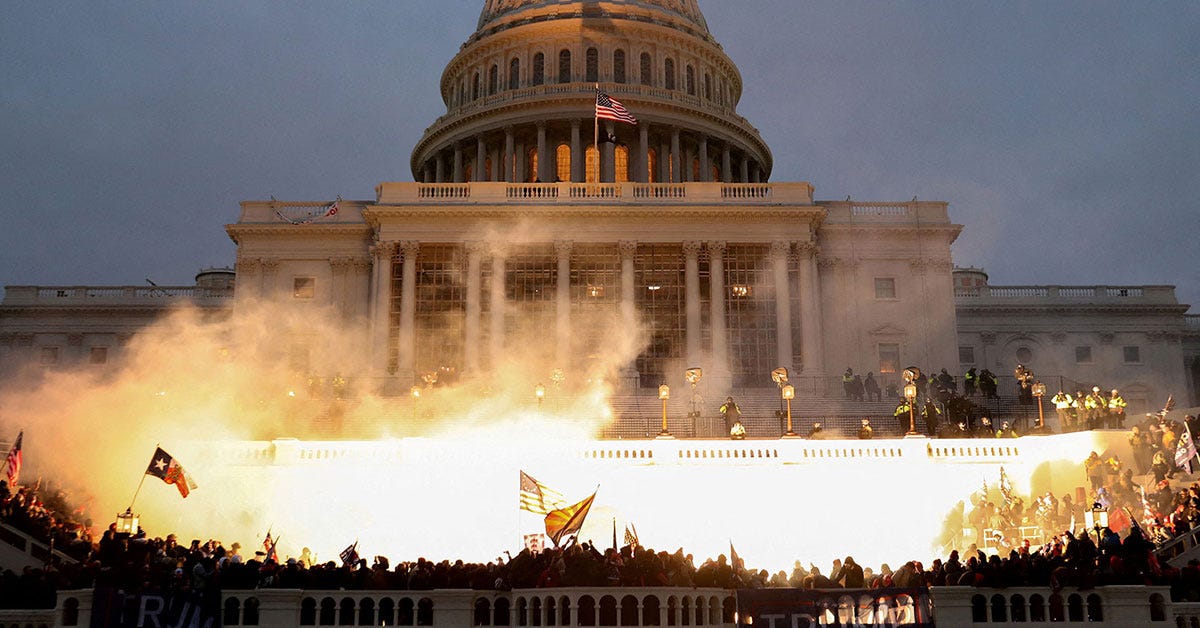Republicans Have Embraced Politically Motivated Violence
Three years after January 6, 2021, we have nary a sign of scruples in the GOP.
Violence courses through American culture. Perhaps, then, it should come as no surprise that today, political violence seems acceptable to one out of every five Americans. Yes, according to a December 2023 poll, 26% of Americans believe that the legal punishments have been “too harsh” for the rioters convicted of crimes on January 6, 2001. In the same poll, 49% of respondents said that the January 6 assault on the Capitol was either “peaceful” or “equally peaceful and violent.” Only a bare majority (50%) said that the (obviously) violent attack was, from their perspective three years later, violent.
The January 6, 2021 attack on the Capitol, to be clear, was a coordinated, violent assault. Organizers intended to disrupt Congress to prevent the certification of Joe Biden and Kamala Harris as the winners of the 2020 election. Some attackers arrived at the Capitol prepared to assassinate members of Congress, while others made ready to take hostages. Five people lost their lives because of the attack. Some 174 police officers were injured by the mob, and four officers who defended Congress that day ended up taking their own lives in the months after they managed to escape.
This level of right-wing violence had been building up for many decades, as many scholars and astute observers of American politics noted at the time. For a short time, in the early 2000s, almost every elected official across the political spectrum claimed to abhor violence. After the two largest politically motivated attacks in the United States in a generation (the 1995 right-wing terrorist attack in Oklahoma City, and the September 11, 2001 attacks by al Qaeda), for a few years there, Republicans and Democrats agreed that outright violence had no place in American elections. (Better to keep all the violence outside the borders of the United States, in faraway places where the Pentagon had plenty of resources and impunity.)
By 2015, when Trump announced his candidacy and began holding rallies where the gathered masses cheered his open calls for beating up journalists and peaceful protesters, it should have been obvious to everyone that the Republican Party was well on its way to accepting right-wing violence. As Carol Anderson and others pointed out, White rage had fully arrived in the 2010s, in part due to backlash amid Barack Obama’s two successful campaigns.

And, sure enough, as Trump’s disastrous presidency began in 2017, he ramped up his support for violence from his fellow Republicans and his supporters on the right-wing. In May 2017, Greg Gianforte, then a Republican candidate for Congress in Montana, choked a newspaper reporter and threw him to the ground. The reporter had merely asked some questions about health care policy. The reporter had to go to the hospital to receive treatment for his injuries. Gianforte at first tried to cover up the assault. A few weeks later, he would go on to win his election, and he was seated in the US House. Later, while he was a member of Congress, he pleaded guilty to misdemeanor assault charges and apologized amid some pressure from then-House Speaker, Republican Paul Ryan. Then-Speaker Ryan may have been the last Republican with a national profile to make a serious effort at holding a co-partisan accountable for engaging in politically motivated violence.
But just a year later, in 2018, at one of his infamous political rallies in Montana, then-President Trump congratulated Gianforte for his physical prowess, praising him for violently attacking a reporter. Today, Gianforte is the Governor of Montana. Republican voters had no problem overlooking Gianforte’s violent past, electing him again and again. Meanwhile, Trump would continue throughout his presidency to opine on the idea that violence should be used as a routine feature of American politics, so long as the violence was in support of himself and his co-partisans in the Republican Party. Trump suffered no electoral consequences for his violent rhetoric, as he won the support of 47% of voters in 2020, including support from 94% of Republicans who voted in that election. Amid defeat in the election, he turned to violence in an effort to remain in office, earning himself the distinction of becoming the first US President to openly disrupt the peaceful transfer of power. His fellow Republicans in the US Senate acquitted Trump of impeachment charges related to his efforts to overturn the election. Today, Trump is the front-runner for his party’s nomination to in the 2024 presidential election.
I am embarrassed to admit that as late as January 5, 2021, I did not expect ever to witness this much open acceptance of political violence within a major political party in the United States. But by now the evidence is clear: the Republican Party is comfortable with using violence to achieve power. The fact that the likes of Greg Gianforte and Donald Trump have suffered no apparent loss in their standing with Republican voters make it clear that Republicans would rather vote for a convicted criminal than for a more “moderate” Republican—to say nothing about voting for a Democrat.



